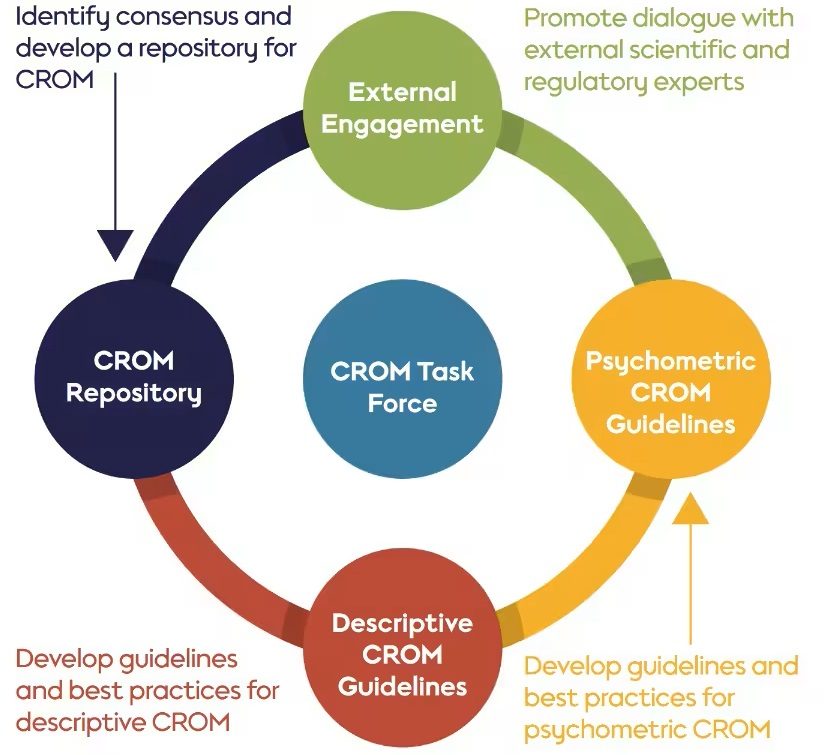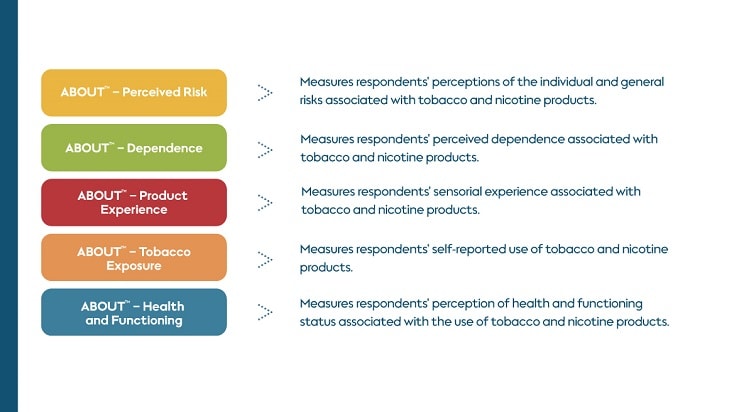Standardized tools for smoke-free product research
Perception and behavior research for smoke-free products
Smoke-free products are changing the landscape for tobacco research and regulation. Designed to provide adult smokers who don’t quit with less harmful alternatives to combustible products, such as cigarettes, these products have the potential to reduce the global burden of smoking-related diseases. Indeed, many countries have adopted them as part of a tobacco harm reduction strategy to improve public health. However, their role in tobacco harm reduction is only possible if adult smokers who don’t quit make the switch to using these alternatives instead.
Perception and behavior research focuses on analyzing adult consumers’ overall perceptions, usage patterns, and experiences of smoke-free products. For example, researchers assess how consumers perceive the health risks associated with smoke-free products, as well as perceived dependence, and product satisfaction. Understanding how consumers use these alternatives and what influences their decision to switch can help guide the development of more suitable products that meet consumers’ needs. These studies can also provide insights into how smoke-free products might affect population health.
In addition to its role in guiding product development, one way that perception and behavior research can help tobacco harm reduction is by assessing consumers’ perception of the relative risk of a smoke-free product before it is marketed. This can ensure that any communications about its risks are accurate, nonmisleading, and scientifically substantiated, allowing adult smokers to gain a clear understanding of the risks and benefits of a smoke-free alternative, without encouraging nonsmokers, youth and former smokers to initiate or reinitiate their use. Ongoing evaluation of risk perception also occurs in a postmarket setting to monitor trends that may affect product usage patterns over time.
The problem of inconsistent data: Why standardized tools matter
For years, studying consumer behaviors and risk perceptions relating to smoke-free products was like solving a jigsaw puzzle with mismatched pieces. Researchers used various tools depending on the product that was assessed, geographical location, and consumer demographics. Although individual studies provided glimpses of insights, the resulting data have often been inconsistent and incomparable, making it difficult to understand the global picture.
Standardized tools and frameworks allow scientists to measure different parameters and outcomes accurately and consistently. Without standardized tools, it is difficult to compare findings across studies, products, regions, or consumer demographics. Additionally, policymakers and regulators rely on consistent and scientifically sound data to assess the risk reduction potential of smoke-free products. Such reliable data can only be achieved with validated methodologies. By employing standardized and validated methodologies, the data are no longer isolated pieces of the jigsaw puzzle, making it easier to build the final picture.
How Philip Morris International (PMI) is shaping perception and behavior research for smoke-free products
PMI has invested heavily in research into consumer perception and behavior related to smoke-free products, with 76 studies completed to date. However, our researchers have also recognized the need for standardized methodologies and set out to create solutions, such as: the CORESTA (Cooperation Center for Scientific Research Relative to Tobacco) CROM (Consumer Reported Outcome Measures) Consortium and the ABOUT™ (Assessment of Behavioral OUtcomes related to Tobacco and nicotine products) Toolbox.
Creating consensus: The CORESTA CROM Consortium
Designing perception and behavior puzzle pieces so that they interlock properly requires collaboration among various stakeholders. Without this alignment, different stakeholders might contribute data pieces that don’t quite match, leading to gaps or inconsistencies in the overall picture.
Until recently, there has been limited consensus on the CROM—self-reported observations intrinsic to the consumer—used in tobacco regulatory science. To harmonize CROM in smoke-free product research, PMI is driving an initiative within CORESTA, an international organization promoting global scientific cooperation in tobacco research. In particular, PMI coordinates the CORESTA CROM Consortium, a collaborative effort involving stakeholders from the tobacco industry, academia, and regulatory agencies, which aims to guide the development, validation, access, and use of CROM for evaluating tobacco and nicotine products (TNPs). To achieve these goals, the initiative focuses on reviewing existing standards and establishing recommendations for developing and validating new CROM. It is also working towards creating a CROM knowledge repository that will help scientists identify the appropriate CROM for their research.

In 2024, the CORESTA CROM Task Force achieved a significant milestone by publishing two guidelines for identifying, developing, validating, and implementing both psychometric (unobservable) and descriptive (observable) CROM. Implementation of these guidelines could create a paradigm shift in the way CROM are conceptualized and implemented and help improve data consistency and comparability in TNP research.
To support dialogue and knowledge sharing, the CROM Task Force also organizes workshops and symposia, mostly as virtual events open to everyone, where researchers from industry, academia, and regulatory agencies present their work. By fostering collaboration and consensus, the CORESTA CROM Consortium is building a robust scientific framework to help provide a clearer picture of how smoke-free products may contribute to public health. This can support better, informed decisions for the regulation of TNPs, ultimately improving public health.
The ABOUT™ Toolbox: PMI’s game changer in standardizing perception and behavior research
The ABOUT™ Toolbox a set of validated, structured research tools, comprising fit-for-purpose CROM (questionnaires). These tools help researchers piece together their understanding of the perceptions and behaviors of adult users of TNPs. This ongoing, collaborative initiative aims to establish easy-to-use, scientifically sound tools and frameworks that can be used to measure perception and behavior in a consistent way to facilitate accurate comparisons.
The ABOUT™ Toolbox consists of five separate CROM, each focusing on different priority areas of perceptions and behaviors related to the use of TNPs.

The ABOUT™ Toolbox CROM are developed using best practices in accordance with the U.S. Food and Drug Administration’s (FDA’s) guidelines on Patient-Reported Outcome Measures and modified risk tobacco product (MRTP) applications as well as the CORESTA CROM guidelines. The iterative process involves different studies and research activities to ensure the development of scientifically validated instruments that are adaptable across various smoke-free product categories, user groups, and cultural contexts. The extensive validation performed during the development process ensures the reliability and effectiveness of the toolbox across different research and regulatory settings. Additionally, global accessibility of the toolbox is enabled through Mapi Research Trust’s ePROVIDE™ platform.
By sharing the toolbox with tobacco research and public health communities, PMI can help ensure that everyone is working with data pieces that can fit together seamlessly. This approach allows researchers to build a more accurate and complete picture of consumer behavior and perception regarding smoke-free products.
Driving collaboration: The Delphi study example
Collaboration and the use of standardized methodologies are key to ensuring consistency and reliability of results and generating comparable and compatible data. A recent example is the global Delphi Panel study, sponsored by PMI, which brought together international experts to align on metrics for evaluating consumer reported outcomes of using smoke-free products. This study formed part of the research phase during the development of one of the five instruments of the ABOUT™ Toolbox: the ABOUT™ – Health and Functioning. The aim was to identify concepts that are important to measure when assessing the health and functioning status of adult smokers switching to smoke-free products, ensuring clinical and cross-cultural relevance.
Experts from diverse fields, including psychology, public health, dentistry, oncology, and internal medicine, refined and ranked health and functioning concepts through three rounds of surveys until a consensus was reached. They identified several core areas to focus on, including physical health, mental well-being, and social functioning, highlighting the importance of capturing both objective and subjective aspects of health and functioning to assess the impact of smoke-free products comprehensively. The consensus-building approach helped address cultural and professional differences, ensuring the concepts were relevant across various populations.
By achieving expert consensus, the Delphi study strengthens the validity and reliability of the ABOUT™ – Health and Functioning instrument, showcasing the value of collaboration and expert consensus in developing scientifically sound and globally accepted instruments for examining consumer perception and behavior in smoke-free product research.
Conclusion: A unified path forward
Evidence-based research on the perceptions and behaviors of smoke-free product users is a key steppingstone in the journey toward minimizing tobacco harm. The development of standardized tools and frameworks, like the ABOUT™ Toolbox and the CORESTA CROM Consortium, is paving the way for a more collaborative, data-driven future. With alignment of methodologies, researchers and policymakers ensure each piece of the puzzle fits perfectly with the others, creating a comprehensive picture of user perception and behavior. As more researchers adopt these tools, tobacco regulation will move toward a unified approach that allows for reliable, large-scale comparisons across products, populations, and geographies. Stronger evidence collected using validated tools can enable policymakers to create effective regulations while addressing concerns about misuse. By fostering global partnerships, aligning methodologies, and generating reliable and comparable data, these tools provide a much-needed foundation for understanding and meeting the needs of adult smokers who don’t quit, aiding their transition away from cigarettes and—the big piece of the puzzle—ultimately promoting public health.

Read the Scientific Update magazine
The Scientific Update magazine is focused on PMI's research and development efforts, milestone studies, industry regulations, and more. View the latest issue, or read the articles online.




